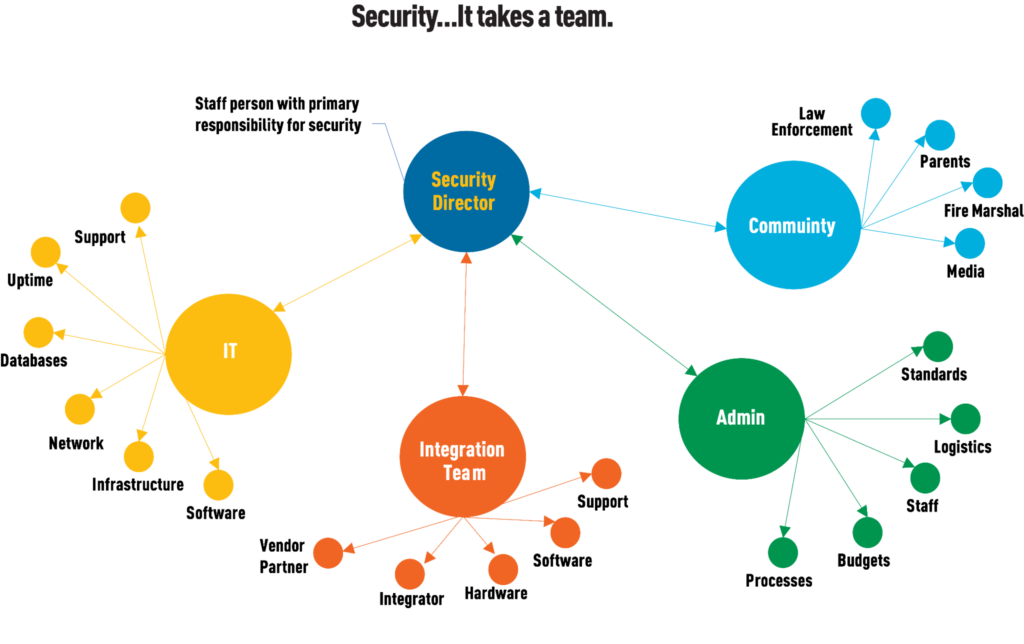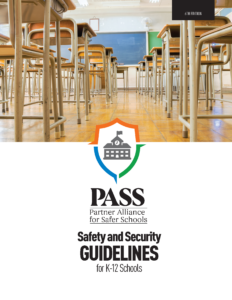Leadership – Achieving Clarity in Your Comprehensive School Safety Plan
Partner Alliance for Safer Schools
White Paper: Leadership – Achieving Clarity in Your Comprehensive School Safety Plan
The volunteers who make up the Partnership Alliance for Safer Schools (PASS) bring together their research and expertise from the education, public safety and industry communities to develop and support a coordinated approach to make effective use of proven security practices for schools. The PASS team is also dedicated to developing white papers on specific, school-safety topics.
The content in these white papers may point to specific products, brands, or organizations as illustrations of how certain safety and security measures are implemented. PASS does not endorse specific products or brands. Together, the volunteers and partners of the PASS share a single vision: making all schools safer is both achievable and urgently needed.
AUTHORS
Authors:
Paul Timm, Director of Education Safety, Allegion
Kevin Wren, Director of Business Development, A3 Communications
Les Nichols, President, R.L. Nichols & Associates
KEY TOPIC
Achieving Clarity in Your Comprehensive School Safety Plan
PROBLEM SOLVED
How to form a team to use the PASS Guidelines to create a security management plan for your school.
RELEVANT PASS GUIDELINES SECTION/S
“Using the PASS Guidelines to Formulate a Comprehensive Security Plan,” PASS K12 Guidelines, 6th Edition, pages 18-19.
MOST RELEVANT FOR
- School administrators and safety officers.
- Government safety administrators.
- Public safety personnel.
- School board members and other governance stakeholders.
- Systems integrators and consultants.
- School stakeholder organizations (e.g., PTA, PTO, PTSA).
TIME TO READ (source)
5 minutes
Introduction
In recent years, PASS trainings have included a “bubble diagram” that helps identify numerous parties involved in school safety and security planning and preparation, as well as how they relate to one another.

Assembling the Team
How we build such a team is often subject to budget constraints and availability of managerial talent. Ideally the team would be led by a security director. However, we know that oftentimes districts do not have the resources to employ a full-time security director. Therefore, other potential candidates – such as the district’s director of transportation, director of facilities, or the business manager – may be tasked with leading the safety planning team.
We recommend utilizing the bubble diagram to assist in identifying stakeholders, making sure to minimally include input from the following:
- Students have technological expertise and insights into the school environment.
- Parents and community organizations will have viewpoints on topics, such as school safety drills.
- Security vendors have expertise in emerging technologies that affect security systems.
- School support staff will see aspects of security that administrators may miss.
Navigating System Complexity
The school safety planning team will have to address the fact that a school security environment is made up of a great number of components. These are best understood and managed as systems, including but not limited to:
- Mass communications.
- Access control.
- Visitor management.
- Interoperability.
- Video surveillance.
- Intrusion detection.
- Weapons detection.
Over recent years the improvement and integration of these systems has been a major goal across the security industry, reducing the complexity of the end-user experience, thus improving emergency and daily operations’ decision making. For example, the majority of camera systems have transitioned from analog to IP (Internet Protocol) systems, allowing them to easily integrate with other systems, streamlining operations. Further, systems should be selected based on their compliance with established industry standards, such as the Security Industry Association (SIA), as well as complying with fire, ADA, and life-safety codes.
Plan, Prepare, Practice
The leadership and members of the safety planning team must be committed to meet regularly – initially perhaps every month or quarter, but in time, twice yearly could suffice. The team should formally draft and adopt one or more security goals, as well as a short list of measurable security objectives, each of which can be broken down into tasks or systems functions.
Finally, the plan must be practiced by:
- Defining individual staff roles and responsibilities.
- Training staff in preventative practices.
- Conducting drills and documenting the results to include tabletop exercises.
- Tracking continued security progress at each school and across the district.
Conclusion
Don’t wait until your school/district has experienced losses to undertake security planning and preparation. Assemble your team and begin this important collaborative process. Now is the time to keep students, staff, and visitors safe.
References
Timm, P. (2021). School security: How to build and strengthen a school safety program (2nd ed.).

Ready to get the Guidelines?
The most comprehensive information available on best practices specifically for securing school facilities, vetted extensively by experts across the education, public safety and industry sectors.
